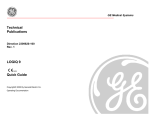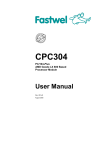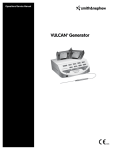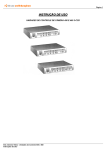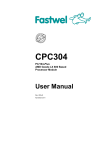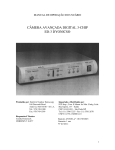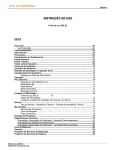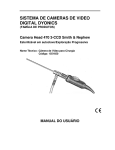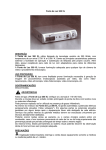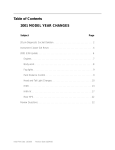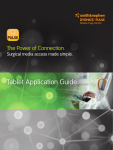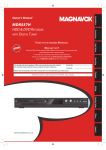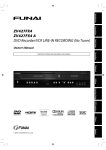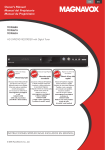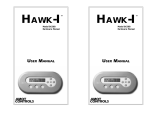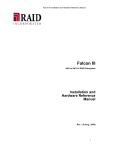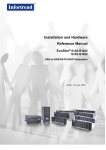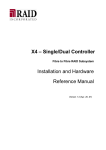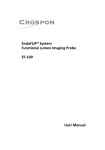Download Smith & Nephew 640 Image Management System
Transcript
Operations/Service Manual Smith & Nephew 640 Image Management System Smart Media MMC & SD Memo ry Comp actFla sh Stick Glossary of Symbols Ethernet Power On Ethernet Port Power Off Microphone Input Main Menu Audio Output Capture or Still Capture Tally Light Output Save Menu Serial Port Keyboard Aux Video Input Date of Manufacture Headphone Input UL Classification Variability Bidirectional Port Eject Non-ionizing Electromagnetic Radiation Caution: See Instructions for Use Parallel Port Electrical Shock Hazard Universal Serial Bus (USB) Port Type B Equipment Y/C Input Fuse Rating Still Freeze Still Capture Loop Thru Video Capture Y/C Output RGB Input RGB Output Video Graphics Array (VGA) Disconnect Before Shipping Smith & Nephew 640 Image Management System Operations/Service Manual 1061407 Rev. F 1 Table of Contents Glossary of Symbols . . . . . . . . . . . . . . .1 Recording Video . . . . . . . . . . . . . . . . .24 Environmental Protection . . . . . . . . . . . . .43 Preface . . . . . . . . . . . . . . . . . . . . . . . . . .3 Reviewing Images and Video Clips . . .24 Service Philosophy . . . . . . . . . . . . . . . . .43 Indications for Use . . . . . . . . . . . . . . . .3 Adding Text Notes . . . . . . . . . . . . . . . .25 Troubleshooting . . . . . . . . . . . . . . . . .44 Contraindications . . . . . . . . . . . . . . . . .3 Save and Reports . . . . . . . . . . . . . . . . . .26 Ordering Information . . . . . . . . . . . . . .45 Product Description . . . . . . . . . . . . . . .3 Saving Procedures . . . . . . . . . . . . .26–27 Warnings and Precautions Warnings . . . . . . . . . . . . . . . . . . . . . . . . . .4 Saving to Multiple CDs . . . . . . . . . . . .27 Frequently Asked Questions (FAQS) . . . . . . . . . . . . . . . . . . . . . .46–47 Generating a Report/Printing . . . . . . .28 Warranty . . . . . . . . . . . . . . . .Back Cover Precautions . . . . . . . . . . . . . . . . . . . . . .4–5 Auto Print . . . . . . . . . . . . . . . . . . . . . . .28 Introduction . . . . . . . . . . . . . . . . . . . . . .5 System Administration . . . . . . . . . . .29–30 Service Replacement Program . . . . . . . . . . . . . . . . .Back Cover HERMES-READY System Information . .5 Integration Broker Introduction . . . . . .30-31 System Components Unpacking the Components . . . . . . . . . . .5 DORAWEB Related . . . . . . . . . . . . . . . .31 Component List . . . . . . . . . . . . . . . . . . . . .5 PACS Related . . . . . . . . . . . . . . . . . . . .31 … HIS Related . . . . . . . . . . . . . . . . . . . . . .31 Front Panel . . . . . . . . . . . . . . . . . . . . . . . . .6 IMS Folder and Sub Folders . . . . . . . . .31 Rear Panel . . . . . . . . . . . . . . . . . . . . . . .7–8 DORAWEB System Integration . . . . . . . . .32 Keyboard . . . . . . . . . . . . . . . . . . . . . . . . . .9 Overview . . . . . . . . . . . . . . . . . . . . . . .32 Touchpad . . . . . . . . . . . . . . . . . . . . . . . . . .9 Configuring DORAWEB System Integration . . . . . . . . . . . . . . . . . . . . . .32 System Installation Overview . . . . . . . . . . . . . . . . . . . . . . . . . .10 Recommended System Configuration . . .11 Configuring the DICOM Send Utility . .33 Step A: Attaching Cables . . . . . . . . . . . . .12 Configuring the 640 Image Management System . . . . . . . . . .34–35 Cable Configuration . . . . . . . . . . . . . . . . .13 Cleaning the Hard Disk . . . . . . . . . . . .36 Step B: Attaching HERMES Digital O.R. Control Center . . . . . . . . . . . . . . . . . . .14 Advanced Topics . . . . . . . . . . . . . . . . . . .37 ® Step C: Attaching the Windows ®-Compatible Printer . . . . . . .14 System Operation Overview . . . . . . . . . . . . . . . . . . . . . . . . . .15 Network Connection . . . . . . . . . . . . . .15 Auto Login . . . . . . . . . . . . . . . . . . . . . .15 System Tools Login . . . . . . . . . . . . . . . .15 Notes on the DVD Drive and Media . . . . . . . . . . . . . . . . . . . . . .37 Notes on the Multi-card Drive and Media . . . . . . . . . . . . . . . . .37 Notes on the 640 Image Management System . . . . . . . . . . . . . .37 Folders and Files on the 640 Image Management System . . . . . . . .37 Login Type . . . . . . . . . . . . . . . . . . . . . . .15 System Specifications . . . . . . . . . . . . .38 Basic Operation . . . . . . . . . . . . . . . . . . . .15 Guidance and Manufacturer’s Declaration – Electromagnetic Immunity . . . . . . . . . . . . . . . . . . . .39-40 Turning Power On . . . . . . . . . . . . . . . . .15 Using the 640 Image Management System Screens . . . . . . . . . . . . . . .16–17 Using the Pointing Devices and Function Keys . . . . . . . . . . . . . . . . .17–18 Using the Touchpad . . . . . . . . . . . . . . .18 Shutting the System Down . . . . . . . . .18 Guidance and Manufacturer’s Declaration – Electromagnetic Emissions . . . . . . . . . . . . . . . . . . . . . . .41 Guidance for Separation Distances . .42 Maintenance/Service System and Keyboard: Patients and Procedures . . . . . . . . . . . . .19 Cleaning the System . . . . . . . . . . . . . .43 Procedure States . . . . . . . . . . . . . . . . .20 Protecting the Keyboard . . . . . . . . . . .43 Adding a New Procedure . . . . . . . . . .20 Moving the 640 Image Management System . . . . . . . . . . . . . . . . . . . . . . . . .43 Changing a Current Procedure . . . . . .21 Deleting a Procedure . . . . . . . . . . . . . .21 Images . . . . . . . . . . . . . . . . . . . . . . . . . .22 Setting Video Options . . . . . . . . . .22–23 Capturing Images . . . . . . . . . . . . . . . .23 Figures 1. Front Panel. . . . . . . . . . . . . . . . . . . . . . 6 2. Rear Panel . . . . . . . . . . . . . . . . . . . . . . 7 3. System Keyboard . . . . . . . . . . . . . . . . 9 4. Touchpad . . . . . . . . . . . . . . . . . . . . . . . 9 5. IEC 60601-1-1 System Configuration. . 11 6. USB Connection . . . . . . . . . . . . . . . . . 12 7. Cable Configuration . . . . . . . . . . . . . . 13 8. 640 System Login Dialog Box . . . . . . 15 9. 640 System Screen . . . . . . . . . . . . . . 16 10. Add New Procedure Box. . . . . . . . . . 20 11. Change Current Procedure Box . . . . . 21 12. Video Settings Dialog Box. . . . . . . . . 22 13. Note Dialog Box . . . . . . . . . . . . . . . . 25 14. Save Dialog Box. . . . . . . . . . . . . . . . . 26 15. Report Dialog Box . . . . . . . . . . . . . . . 28 16. System Tools Dialog Box. . . . . . . . . . 29 17. Integration Folder. . . . . . . . . . . . . . . . 30 18. DORAWEB System Dialog Box . . . . . 32 19. DICOM Send Utility Dialog Box . . . . . 33 20. DICOM Send Configuration Dialog Box . . . . . . . . . . . . . . . . . . . . . 33 21. System Configuration Dialog Box Policies . . . . . . . . . . . . . . . . . . . . . . . 34 22. System Configuration Dialog Box Data Systems and Devices . . . . . . . . 35 23. Disk Maintenance Dialog Box. . . . . . 36 Tables 1. Guidance and Manufacturer’s Declaration - Electromagnetic Immunity . . . . . . . . . . . . . . . . . . . 39–40 2. Guidance and Manufacturer’s Declaration - Electromagnetic Emissions . . . . . . . . . . . . . . . . . . . . . . 41 3. Guidance for Separation Distances . 42 Data Storage Media: Caring For Removable Disks and CD Media . . . . . . . . . . . . . . . . . . . . . . . . . .43 Preventative Maintenance: Recommended Annual Performance Checks . . . . . . . . . . . . . . . . . . . . . . . . .43 Electrical Interference . . . . . . . . . . . . . . .43 2 Smith & Nephew 640 Image Management System Operations/Service Manual 1061407 Rev. F Preface/Indications for Use/Contraindications/ Product Description Preface This manual contains general information, together with setup, operation, and maintenance instructions, for the Smith & Nephew 640 Image Management System. It is essential that all materials in this manual be read and understood before any attempt is made to operate or maintain the system. Indications for Use To capture intraoperative still and motion images. Contraindications None known. Product Description The 640 Image Management System is designed to be used to capture intraoperative still and motion images using the camera system, front panel, keyboard, or using optional voice-activated or touch panel control via the HERMES Digital O.R. Control Center. Images are then stored as standard image file formats on transportable media, or exported to an Ethernet network for long-term archival, retrieval, or printing using third-party image application software or the Smith & Nephew DORAWEB™ Surgical Documentation System. Smith & Nephew 640 Image Management System Operations/Service Manual 1061407 Rev. F 3 Warnings and Precautions To ensure maximum performance, safe operation, and full warranty protection of the Smith & Nephew 640 Image Management System, please read and follow these warnings and cautions. Precautions Warnings • To reduce the risk of electric shock, do not remove the unit's cover or back panel. Refer servicing to qualified service personnel. • DANGER: Risk of explosion if used in the presence of flammable anesthetics. • If a power strip is used, ensure that it is not placed on the floor. • Prior to initiating system installation ensure that there is no electrical power to any of the system components. • If this unit is configured as part of a system, the entire system should be tested for compliance with IEC 60601-1-1. • If the leakage current of the configured system exceeds the limits of IEC 60601-1-1, install an appropriately rated UL 60601-1/IEC 60601-1 approved isolation transformer and retest the system. • The use of accessory equipment not complying with the equivalent safety requirements of this equipment may lead to a reduced level of safety of the resulting system. Consideration relating to the choice shall include: Use of the accessory in the patient vicinity. Evidence that the safety certification of the accessory has been performed in accordance with UL 60601-1/IEC 60601-1/IEC 60601-1-1 and/or CAN/CSA C22.2 No. 601.1. • Check leakage currents when interconnecting this unit with other equipment. • Do not operate at line voltages other than those stipulated on the back of the unit. • Prior to cleaning the system turn off all power to the system and disconnect it from the power source. U.S. Federal law restricts this device to sale by or on the order of a physician. • This 640 Image Management System does not ship with virus scanning software installed. Before operation, it is important to install virus scanning software on the 640 Image Management System if the 640 Image Management System is to be networked or if the user will use non-blank or reusable recording media such as flash media or compact discs. • The 640 Image Management System complies to IEC 60601-1-2, however, the user must be aware that this does not necessarily ensure protection of the unit against interference from other devices. • Electrical safety testing should be performed by a biomedical engineer or other qualified person. • This equipment is designed and tested to minimize interference with other electrical equipment. However, if interference occurs with other equipment it may be corrected by one or more of the following measures: Reorient or relocate this equipment, the other equipment, or both. Increase the separation between the pieces of equipment. Connect the pieces of equipment into different outlets or circuits. Consult a biomedical engineer. • Handle unit with care. If the unit is dropped or damaged in any way, it must be returned immediately to Smith & Nephew for service. • Maintenance: At least annually, the electrical safety conditions should be checked to ensure compliance with IEC 60601-1. • Do not unplug the system power cable or interrupt the power source at any time while data is being acquired. Images and video clips may be lost. • Do not allow water or other fluids to enter the multi-card reader or CD/DVD drives on the front panel. 4 Smith & Nephew 640 Image Management System Operations/Service Manual 1061407 Rev. F Precautions/Introduction/HERMES-Ready™ System Information/ System Components • The CD/DVD drive unit should only be used with blank CD-R and/or CD-RW 650 MB or 700 MB disk media and blank DVD-R and/or DVD-RW 4.7 GB disk media. • Do not unplug the system power cable or interrupt the power source at any time while the data is being written to the CD/DVD-R/CD/DVD-RW media. Doing so will render the CD/DVD-R/ CD/DVD-RW disk unusable. • This equipment contains electronic printed circuit assemblies. At the end of the useful life of the equipment it should be disposed of in accordance with any applicable national or institutional related policy relating to obsolete electronic equipment. Introduction The Smith & Nephew 640 Image Management System enables the acquisition, review, export, and printing of still images and video clips. A basic patient record containing patient demographic information and notes is also created directly on the system. The patient record and all still images and video clips can be stored on flash media, 650 MB or 700 MB CD media, 4.7 GB DVD media or exported to an Ethernet network. Exported data can be viewed using standard third-party software or the Smith & Nephew DORAWEB™ Surgical Documentation System. To obtain a copy of the Release Notes and “bug fixes” for Version 2.0, please contact your authorized Smith & Nephew Representative. HERMES-Ready… System Information The 640 Image Management System is configured to be connected to the HERMES Digital O.R. Control Center via the HERMES port, which uses RS-232 serial communications protocol. When connected, the system functions may be accessed by direct voice commands or by manual use of a touch screen control. Center Operating and Maintenance Manual for the proper setup, use, and troubleshooting of the device. System Components Unpacking the Components Carefully unpack and inspect all of the components shipped with the 640 Image Management System. Compare components received with those shown below. Component List You should have received the following: Quantity Description 1 1 1 1 1 1 2 1 1 3 1 1 1 1 640 Image Management System Keyboard (Installed) 650 MB or 700 MB CD-R Compact Disk 4.7 GB DVD-R Touchpad (Installed) Power Cord, Hospital-Grade Service Stickers Cable, Y/C (S-Video), 6 ft, M to M Cable, RGBS, 6 ft, M to M Cable, 3.5 mm Mini-Plug Cable, Mini-Plug/RCA Phono Plug VGA Termination Plug Tally Light Cable Software Agreements Windows ® License If any parts are missing or damaged, please contact your authorized Smith & Nephew sales representative. Save the carton and packing materials in the event a component needs to be returned for repair. For information about ordering additional supplies, refer to the “Ordering Information” section. It is recommended that the physician and support personnel are thoroughly familiar with the setup and operation of the HERMES Digital O.R. Control Center. Please refer to the HERMES Digital O.R. Control Smith & Nephew 640 Image Management System Operations/Service Manual 1061407 Rev. F 5 System Components Front Panel Figure 1. Smith & Nephew 640 Image Management System Front Panel Power Switch: Activates power to the unit. Multi-card Reader: Accepts the following media types: Smart Media, Compact Flash, SD/MMC or Memory Stick. LED flashes when media is inserted and recognized. Storage capacity varies depending on user preference and market availability. CD/DVD Drive: Accepts 650 MB or 700 MB CD-R/RW or 4.7 GB DVD-R/RW media. Includes a Headphone input (not used with this system), Volume control (not used with this system), and Eject button. The Eject button is used to open and close the CD/DVD-RW tray. AUX VIDEO INPUT: Accepts any composite video signal from an external source such as a C-Arm or ultrasound device. MAIN MENU Button: Displays 640 System screen of the user interface on the surgical display. CAPTURE Button: Acquires still image shown on the screen. SAVE MENU Button: Displays the Procedure Save dialog box of the user interface on the surgical display. LED Display: Lights flash to indicate activity. AUX Button: Switches between AUX and camera input signals. 6 Smith & Nephew 640 Image Management System Operations/Service Manual 1061407 Rev. F System Components Rear Panel Figure 2. Smith & Nephew 640 Image Management System Rear Panel Safety and Regulatory Labels Y/C Input: From camera system's Y/C output. Hospital Grade AC Input Receptacle Y/C Output: Y/C output to additional video components. Removable Fuse Block Fan: Cools the system. Keyboard Input: System keyboard. Keyboard RGB Input: From camera system's RGB/SYNC output. RGB Output: RGB/SYNC signal to additional video components. Bidirectional Port: Serial communication connection to HERMES ® Digital O.R. Control Center. Ethernet: Ethernet network connection. Smith & Nephew 640 Image Management System Operations/Service Manual 1061407 Rev. F Still Capture: Accepts input activated by camera head button or optional footswitch. Still Capture Loop Thru: The Still Capture input port is simultaneously routed as an output signal to this port. The Loop Thru port can be connected to a video printer so both the system and the video printer can be operated from the same camera head button or the optional footswitch control. 7 System Components Rear Panel Still Freeze: Accepts input activated by camera head button or optional footswitch instructing system to freeze presently displayed video image. A second press returns display to live video. Video Capture: Accepts input activated by camera head button or optional footswitch instructing system to start video acquisition. A second press stops acquisition. Microphone: Audio input from line level audio source. Audio Out: Outputs line level audio signal when playing back captured video. Tally Light: Outputs signal instructing Tally Light to turn on during video acquisition. Used only with compatible surgical displays. 8 Serial Port: Touch panel input port. Universal Serial Bus (USB) Port: Bidirectional input/output port for use with USB peripherals such as printer and pointing devices (touchpad, mouse, etc.) Parallel Port: Bidirectional parallel communication port for use with local printers. Video Graphics Array (VGA): Outputs video graphics array signal for use with optional computer monitor/touch panel. Disconnect Before Shipping: Disconnect the keyboard and touchpad cables and wrap them securely with the Velcro ® fastener before shipping the system. Smith & Nephew 640 Image Management System Operations/Service Manual 1061407 Rev. F System Components Keyboard Display Mode Figure 3. Smith & Nephew 640 Image Management System Keyboard The keyboard and touchpad are located in the bottom drawer of the 640 Image Management System. The keyboard and cable are secured in the drawer with a Velcro ® fastener. To minimize drawer obstruction, rewrap the cable securely with the Velcro fastener when storing. General Keyboard Functions Left and Right Arrows = Move cursor on the selected highlighted line entry. Left Button Right Button Figure 4. Touchpad Up and Down Arrows = Move cursor between fields. For information regarding function keys, refer to the “Using the Pointing Devices and Function Keys” section. Smith & Nephew 640 Image Management System Operations/Service Manual 1061407 Rev. F 9 System Installation Overview The following pages summarize the steps required to install and configure the Smith & Nephew 640 Image Management System. Each 640 Image Management System configuration may vary depending on the camera system and components used. Figure 5 indicates a system configuration that complies with IEC 60601-1-1 requirements. Figure 7 indicates one example of component configuration and interconnection. Important: Prior to initiating system installation all the Warnings and Cautions (reference Page 4) must be thoroughly read and understood. Caution: This 640 Image Management System does not ship with virus scanning software installed. Before operation, it is important to install virus scanning software on the 640 Image Management System if the 640 Image Management System is to be networked or if the user will use non-blank or reusable recording media such as compact discs, DVDs or removable flash media. 10 Smith & Nephew 640 Image Management System Operations/Service Manual 1061407 Rev. F System Installation Recommended System Configuration IEC 60601-1-1 Compliant System Configuration Figure 5 indicates a system configuration that complies with IEC 60601-11 requirements. Warning: If this unit is configured as part of a system, the entire system should be tested for compliance with IEC 60601-1-1. • If the leakage current of the configured system exceeds the limits of IEC 60601-1-1, install an appropriately rated • UL 2601-1/IEC 60601-1 approved isolation transformer and retest the system. The use of accessory equipment not complying with the equivalent safety requirements of this equipment may lead to a reduced level of safety of the resulting system. Consideration relating to the choice shall include: – Use of the accessory in the patient vicinity. – Evidence that the safety certification of the accessory has been performed in accordance with the appropriate UL 2601-1/IEC 60601-1 and/or IEC 60601-1-1. IEC 60601-1/UL 60601-1 MEDICAL GRADE ISOLATION TRANSFORMER COLOR VIDEO MONITOR WITH A VA RATING ≥ 1000 Toroid ISB-100W Sony PVM-20M2MDU REF 7206091 Note: Isolation Transformer required for 220/240 VAC setup only or DYONICS™ Vision 818 REF 7209067 AC Input AC Input AC Output Wall Receptacle COLOR VIDEO PRINTER Sony UP-51MD REF 7207801 or MEDICAL GRADE POWER STRIP Sony UP-51MDU REF 7207812 SUITABLE FOR EXPECTED LOAD SL Waber XULMC6-023 AC Input AC Output AC Input SMITH & NEPHEW CAMERA CONTROL UNIT DYONICS™ ED-3 Camera Control Unit NTSC REF 7206063/PAL REF 7206065 LIQUID CRYSTAL DISPLAY TOUCH PANEL or Smith & Nephew 15" REF 7210344 National 15" 90M0312 Smith & Nephew 19" REF 7210345 National 19" 90M0225 DYONICS™ Vision 325Z Camera Control Unit NTSC REF 7207445/PAL REF 7207446 or AC Input DYONICS™ HD 900 Camera Control Unit NTSC REF 7206080/PAL REF 7207395 or DYONICS™ Vision 325Z DV Camera Control Unit NTSC REF 7209070 AC Input SMITH & NEPHEW LIGHT SOURCE DYONICS™ 300XL Xenon Light Source REF 7206084 or TriVex™ System 300XL Xenon Light Source REF 7207449 AC Input SMITH & NEPHEW 640 IMAGE MANAGEMENT SYSTEM REF 7210233 AC Input HERMES® DIGITAL O.R. CONTROL CENTER REF 7209756 Figure 5. IEC 60601-1-1 Compliant System Configuration Smith & Nephew 640 Image Management System Operations/Service Manual 1061407 Rev. F AC Input 11 System Installation Step A: Attaching Cables Use the following instructions to attach the system to a Smith & Nephew camera (or similar device) and other devices. One standard configuration is presented in Figure 7. This configuration enables still images and video clips to be acquired using two camera head buttons. Other configurations can be used. 1. Connect RGB/SYNC and Y/C Output on the back of the camera control unit to the RGB/SYNC and Y/C Input on the rear of the 640 Image Management System. Note: The 640 Image Management System can capture still images from RGB/SYNC, Y/C, or composite video input and it can only capture video clips from Y/C or composite video input. 2. Connect two mini-plug cables from the SW1/SW2 or Blue/Gray Output on the back of the camera control unit to the Still Capture and Video Capture input ports on the back of the system. (The optional footswitch can be used in lieu of the camera head buttons.) 3. To print to a color video printer when a digital still image is acquired, connect the video printer to the Still Capture Loop Thru port using the third mini-plug cable. Connect the RGB/SYNC and Y/C outputs on the 640 Image Management System to the RGB/SYNC and Y/C inputs on the printer. Connect the RGB/SYNC and Y/C outputs on the printer to the RGB/SYNC and Y/C inputs on the monitor. 4. Connect the multi-pin, circular connector attached to the keyboard, to the Keyboard port on the back of the system. 5. Connect the touchpad to the bottom USB port (port #2). 12 Figure 6. USB Connection 6. (Optional) Connect the Tally Light cable from the Tally Light output on the system to the Remote 1 input on the back of the surgical display. This will enable the Tally Light to illuminate while digital video clips are being acquired. 7. Connect a network cable (optional) to the Ethernet port using a standard RJ45 Cat 5 Ethernet cable. Caution: This 640 Image Management System does not ship with virus scanning software installed. Before operation, it is important to install virus scanning software on the 640 Image Management System if the 640 Image Management System is to be networked or if the user will use non-blank or reusable recording media such as flash media, DVDs or compact discs. 8. Connect the power cord to the rear of the system. Smith & Nephew 640 Image Management System Operations/Service Manual 1061407 Rev. F System Installation Cable Configuration Figure 7. Standard Cable Configuration for Still Image and Video Clip Acquisition Smith & Nephew 640 Image Management System Operations/Service Manual 1061407 Rev. F 13 System Installation Step B: Attaching HERMES ® Digital O.R. Control Center Refer to Figure 7 and the HERMES Digital O.R. Control Center Operating and Maintenance Manual for operation and configuration of the HERMES Control Center with the 640 Image Management System. Step C: Attaching the Windows ®Compatible Printer You can install and configure a standard Windowscompatible printer with the 640 Image Management System in three different ways: • Connected locally to the USB port. • Connected locally to the LPT parallel port. • Connected as a network printer. Configure the printer via the System Tools dialog box. 14 Smith & Nephew 640 Image Management System Operations/Service Manual 1061407 Rev. F System Operation Overview Network Connection The Smith & Nephew 640 Image Management System may be configured as part of a system connected to an Ethernet network allowing exported data to be viewed using Smith & Nephew’s DORAWEB™ Surgical Documentation System, your institution’s Picture Archiving Communication System (PACS), or standard third party image viewing tools. If your system is to be configured as part of a network you should review System Administration section, DORAWEB System, Integration Broker Introduction, and System Configuration. If your installation is not configured as part of a network you should disregard all references to DORAWEB or PACS or Integration Broker functionality in the following section. Auto Login The 640 Image Management System comes from the factory configured to Auto Login when the system is powered up. If required the system may be configured to require a System Login (Figure 8) at power up, review System Administration section System Configuration on page 28 and Configuring the 640 Image Management System on page 32. System Tools Login The Smith & Nephew 640 Image Management System will always require an Administrator Login (Figure 8) to access the System Tools dialog box, review System Administration on page 28. Login Type The login type may be configured as “Simple” requiring only a password to be entered in the Login Boxes (User Name and Domain lines will be grayed out [Figure 8]) or as “Windows” requiring all three lines of information. The 640 Image Management System comes from the factory with the Login Type set as “Simple” and the simple password as “SNE640”. Caution: If the Windows ® Login is required the system administrator must confirm that the appropriate accounts and policies are set up using standard Windows System Tools. See Release notes for details on restrictions to using Windows 2000 Login Type. Basic Operation Turning Power On To turn on the power: 1. Press the POWER switch on the front panel to ON. Initialization begins and the surgical display displays the “Please Stand By” message. 2. After initialization is complete, the 640 System screen displays either on the surgical display or on the computer monitor/touch panel, if one is installed and configured on your system. Figure 8. 640 System Login Dialog Box The system administrator can also configure the 640 System Login to verify multiple user accounts. Smith & Nephew 640 Image Management System Operations/Service Manual 1061407 Rev. F 15 System Operation Using the 640 Image Management System Screens The left side of the 640 System screen contains: • • • • Procedure Information describing the current procedure by the patient’s full name, Medical Record Number (MRN), date of birth, sex, surgeon’s name, and procedure type. Buttons provide access to additional dialog screens for Patient Information, Note Creation, Save Functions, Report Print, and Close Procedure Functions. Note: The Close Procedure button should be used with caution. This operation will close the current procedure. Once closed, features such as image capture will not be functional. Display Mode controls the output to the Surgical Display. Live Video mode displays the live video signal from the Camera Control Unit (CCU) on the surgical display. Main Menu Mode displays the 640 Image Management System Screen on the surgical display. • • • • • • Capture Controls are provided to preview and capture still video images and to capture and play back video clips. The Disk Usage Progress Bar display the amount of space used by the currently stored images. It may be configured to display the usage of a CD/DVD or flash media. It may also be configured to display the usage of the system’s Hard Disk. Each increment on the bar is equal to 5% of total disk space. The progress bar will come configured to indicate CD/DVD usage. To reconfigure the bar refer to the “Configuring the 640 Image Management System” section. The System Tools button provides the system administrator password protected access to a System Tools dialog for system configuration. Refer to the “System Administration” section. The Video Settings button provides the user access to Video Input Option, Capture File Option, and Surgical Display Option settings. Refer to the “Setting Video Options” section. The Shut Down button initiates a controlled system shut down. Refer to the “Shutting the System Down” section. Figure 9. 640 System Screen 16 Smith & Nephew 640 Image Management System Operations/Service Manual 1061407 Rev. F System Operation • • • • • • At the top of the right side of the 640 System Main Screen is the Review Box. The last image captured will automatically be displayed in the Review Box. Below the review box is the Thumbnail Display Box where all available images and video clips for the current procedure are listed. Still images are displayed as thumbnails (small versions), video clips are indicated by the icon. They are listed in time order, with the newest at the end of the list, and are each labeled with a capture time stamp in the form “HHMMSS” where “HH” is the hour, “MM” is the minute, and “SS” is the second. The file extension (the characters after the period) indicates the file type: BITMAP (.bmp), JPEG (.jpg), or MPEG (.mpg). The name of the captured still image or video clip is editable by placing the cursor on the name, left-clicking the touch pad pointing device once, pausing and clicking again. The name may then be changed. The file extension; however, should not be changed. Any previously captured still images may be displayed in the review box by clicking on it’s thumbnail to select and display it. A video clip may be reviewed by clicking on the icon and pressing the Playback button. Refer to the “Reviewing Images and Video Clips” section. The Print button allows the user to print the currently selected still image. All the images available for the current procedure may be printed in one report by accessing the Report dialog. Refer to the “Generating a Report” section. The Delete button allows individual or multiple selected images and video clips to be deleted by the user. For additional information regarding deleting multiple images refer to the “Cleaning the Hard Disk” section. Using the Pointing Devices and Function Keys There are two ways to navigate or move through the system screens: • Click a button using your touchpad pointing device. Refer to the “Using the Touchpad” section. If the system has been configured with the optional VGA touch panel, buttons may be activated by touching them directly on the screen. • Press the equivalent function key for a button – for example, press <F12> instead of clicking the Save button. Note: The instructions in this manual describe using the first technique, clicking buttons, but you can use the navigation technique that you find most convenient. All of the function keys are defined as follows: <ESC> Toggle Video Mode (equivalent to the Display Mode: Live Video/Main Menu button on the 640 System screen). <F1> Reserved for future use. <F2> Display the 640 System screen with the most recently captured image on the surgical monitor (equivalent to the Display Mode: Main Menu button on the 640 System screen). <F3> Preview captured image (equivalent to the Preview button on the 640 System screen). <F4> Capture the still image currently displayed on the video monitor (equivalent to the Capture button on the 640 System screen). <F5> Start or stop recording a video clip (equivalent to the Record and Stop buttons on the 640 System screen). Turn on the screen display of image sequence numbers (equivalent to the On-Screen Display: On radio button in the Video Settings dialog box). <F6> <F7> Turn off the screen display of image sequence numbers (equivalent to the On-Screen Display: Off radio button in the Video Settings dialog box). <F8> Set the video input to RGB (equivalent to the Input: RGB radio button in the Video Settings dialog box). <F9> Set the video input to S-Video (equivalent to the Input: S-Video radio button in the Video Settings dialog box). <F10> Equivalent to the OK button. Smith & Nephew 640 Image Management System Operations/Service Manual 1061407 Rev. F 17 System Operation <F11> Play the most recently recorded video clip (equivalent to the Playback and Stop buttons on the 640 System screen). <F12> Open the Save Dialog (equivalent to the Save button on the 640 System screen). In addition, you can use the up and down arrow keys and the left and right arrow keys to move through the text fields and lists in the dialog boxes, making each successive one active. The Enter button may also be used to move through the text fields. Using the Touchpad The touchpad is an easy way to control your computer screen. Simply glide your finger over the surface of the touchpad to move the cursor on the screen. Shutting the System Down To shut down the Smith & Nephew 640 Image Management System: 1. On the 640 System screen, click Shut Down. A dialog box will first appear to confirm or cancel shutdown. 2. If you confirm shutdown and a procedure is current, you are prompted to close the procedure. If you decide to not close the procedure, the procedure will remain current when the system is started up again. 3. Important: Wait for the system to prompt the operator that it is now safe to turn off the system. 4. Turn the POWER switch on the front panel of the 640 Image Management System to OFF. To click a button on the screen, glide your finger to move the screen cursor over the desired button and then gently tap your finger. You can also use the buttons on the bottom of the touchpad to left- or right-click. To double-click, click the left button twice or click the right button once. To scroll, place your finger down on the right edge of the touchpad and glide up or down. Note: The touchpad responds best to a very light, crisp tap of the finger. 18 Smith & Nephew 640 Image Management System Operations/Service Manual 1061407 Rev. F System Operation Patients and Procedures The following describes the information stored in the system about each procedure: Last Name: The patient’s last name (a maximum of 26 characters for the entire name). First Name: The patient’s first name (a maximum of 26 characters for the entire name). M. Initial: The patient’s middle initial (one character maximum). DOB: The patient’s date of birth (mm/dd/yyyy). Sex: The patient’s sex (F or M). MRN: The patient’s Medical Record Number (a maximum of 26 characters). Surgeon: The surgeon’s name (a maximum of 26 characters). Procedure: Indicates Type of procedure being performed. May be input manually or selected from the Procedure Type pull down list that will be available if the Smith & Nephew 640 Image Management System is networked as part of a DORAWEB™ Surgical Documentation System, PACS or a Hospital Information System (HIS). Procedure ID: Visible only when Show Procedure ID is checked. For non-DORAWEB™ users the MRN field is a required field. Note: Users who do not use the DORAWEB System may skip the following. For DORAWEB users the following fields are required fields: Last Name First Name MRN Surgeon Procedure In earlier versions of the 640 System software this information was available to the 640 System via the Update List function in the Patient module. Users can continue to use this option; however, they can also enter patient information in the 640 System and then transfer the information to the DORAWEB System when the procedure is completed. The DORAWEB software requires the above five fields to process the information, therefore, they are required fields in the 640 software for DORAWEB users. Users who intend to enter patient information for DORAWEB in the 640 System for the first time are required to check the DORAWEB/Network check box in the Save module (Figure 14). This action will put an * next to all the required fields. The default screen does not show the Procedure ID. Users who want to enter a Procedure ID manually can do so. First, the user must click on Data Systems and Devices in “System Configuration”. The Show Procedure ID box needs to be checked (Figure 22). On the Main Menu there will now be an additional field called Procedure ID. Smith & Nephew 640 Image Management System Operations/Service Manual 1061407 Rev. F 19 System Operation Procedure States Each procedure will be in one of three states at any given time: • Queued – The procedure has been scheduled and appears in the Procedure List, but does not yet have any acquired images or video clips. • Current – There is only one current procedure the procedure that is currently being displayed on the 640 System screen. • In Process – The procedure has at least one acquired image or video clip. When you create a new procedure, it begins in the queued state and displays in the Procedure List. When a procedure is selected from the list it is marked as “Current” and remains current until a new procedure is selected from the list. The original procedure is then marked “In Process” and remains available through the Save and Report functions. Refer to the “Save and Reports” section. Adding a New Procedure To add a new procedure: 1. 2. If using DORAWEB/PACS/HIS, click Update List. The system will acquire the most recent schedule of procedures from these systems. Users who want to transfer procedure information to the DORAWEB System after "first" entering it at the 640 System must have the DORAWEB/Network check box selected in the Save module. This action will cause the procedure information to show up with five required fields, making it compatible to transfer to the DORAWEB System later. 3. Select the first entry. The Procedure Information fields display the blank data fields. 4. Click on a field and enter information. Use the ‰ and the ¬ arrows or the enter button, on the keyboard or the touchpad to move from field to field. 5. To enter the Procedure Type, select a procedure type from the drop-down list or click within the Procedure field’s text area and then type in the new information. 6. Click Save to save the new information or click Cancel to not add the new procedure. 7. Click OK to close the dialog box. On the 640 System screen, click Patient. The Patient dialog box displays. In the Procedure List, the first entry is labeled <Add new procedure> (Figure 10). If you are not using DORAWEB/PACS/HIS, proceed to Step 3. Figure 10. Add New Procedure Box 20 Smith & Nephew 640 Image Management System Operations/Service Manual 1061407 Rev. F System Operation Changing a Procedure When a procedure is current or in process (at least one image or video clip has been acquired) stored information regarding the procedure cannot be changed. To change the stored information for a queued or current procedure (not allowed for procedure in process): 1. 2. 3. 4. 5. On the 640 System screen, click Patient. The Patient dialog box displays. If you are not using DORAWEB™/PACS/HIS, proceed to Step 3. If using DORAWEB/PACS/HIS, click Update List. The system will acquire the most recent schedule of procedures from these systems. In the Procedure List, click the entry for the patient whose procedure you want to change. If there is more than one procedure scheduled for this patient, there will be multiple entries in the list. The Procedure Information fields display the stored data. Click Edit to change the data. To change the type of Procedure, select a different procedure type from the Procedure Type drop-down list or click within the Procedure field’s text area and then type in the new information. To change any of the other fields, click within the field’s text area and then type in the new information. 6. Click Save to save the new information or click Cancel to leave the stored data unchanged. 7. Click OK to close the dialog box. Deleting a Procedure To delete a procedure: 1. 2. 3. 4. 5. On the 640 System screen, click Patient. The Patient dialog box displays. If you are not using DORAWEB/PACS/HIS, proceed to Step 3. If you are using DORAWEB/PACS/HIS, click Update List. The system acquires the most recent schedule of procedures from the DORAWEB System. In the Procedure List, click the entry for the patient whose procedure you want to delete. If there is more than one procedure scheduled for this patient there will be multiple entries in the list. The Procedure Information fields display the stored data. Click Delete to delete the procedure. Note: Once you delete a procedure, it can be recovered by reloading the procedure list via the DORAWEB/PACS/HIS Systems using the Update List button. Click OK to close the dialog box. Figure 11. Change Current Procedure Box Smith & Nephew 640 Image Management System Operations/Service Manual 1061407 Rev. F 21 System Operation Images • Setting Video Options To set the video options: 1. On the 640 System screen, click Video Settings. The Video Settings dialog box displays, with areas for video options, capture file options, and surgical display options. 2. Set the type of video input. You can choose one type of input from RGB, S-Video, and Auxiliary. If any of these types are not available on your installation, they are grayed out so you cannot select them. Note: Video clips can only be recorded using the S-Video or composite video (front panel) input channel. 3. By default all still images are captured in Bitmap (.bmp) format. Bitmap files are uncompressed files that are approximately 1 MB in size. You can set additional image capture file options: • If DICOM is enabled and selected on the 640 System screen you will also capture images in a DICOM-compatible (.dcm) format. • • If JPEG is enabled and selected on the 640 System screen you will also capture images in JPEG (.jpg) format. You can set the quality to Standard (higher compression of 20:1, with an average file size of 50 KB) or High (lower compression of 10.5:1, with an average file size of 85 KB). Note: The DORAWEB™ System imports Bitmap, JPEG, and DICOM still images and video clips. When capturing images for export to the DORAWEB System, JPEG is the recommended format to allow image annotation. For video clips select MPEG1 or MPEG2 (.mpg) format. MPEG1 generates half the video resolution with smaller file sizes. MPEG2 generates full video resolution with larger file sizes. To help ensure that all information acquired for a given patient fits onto the target medium (including flash and CD), set the maximum MPEG File size to 100 MB, 200 MB, or 600 MB. This will automatically break long video clips into smaller, more manageable file sizes. You can capture data up to a maximum of 2 GB total per procedure, which is stored on the 640 internal hard disk. Figure 12. Video Settings Dialog Box 22 Smith & Nephew 640 Image Management System Operations/Service Manual 1061407 Rev. F System Operation • The Smith & Nephew proprietary Motion Correction Filter for analog video can be turned on or off. The filter reduces blurring artifacts in acquired images. This is a post-processing filter that runs for approximately three seconds per image. Note: When acquiring images from devices such as C-arms or ultrasound units, the recommended setting is off. 4. Set the surgical display options: • Turn the On-Screen Display of image sequence numbers on, off, or set to momentary (three second display). • Turn the display of captured images off or set to momentary (the live video is replaced by the captured image for three seconds). • Set the playback of video clips on the surgical display to Yes or No. 5. Click OK to save the video settings and close the dialog box. Capturing Images In Live Video Mode images from the camera control unit are displayed on the surgical display. If the onscreen display is turned to on or momentary, the sequence number in the lower left corner of the screen indicates the number of still images and video clips that have been acquired. The letters in the lower left corner of the screen indicate the video input (RGB, Y/C or AUX). Still images are initially configured in Bitmap format. To capture images in JPEG and/or DICOM format, click the associated checkboxes on the 640 System screen. To capture images for the current procedure: 1. If you want to first freeze the live video, click the Preview button on the 640 System screen. Note that this is not necessary. Click Capture and Close or Cancel to return to live video. 2. On the 640 System screen, click Capture . The image currently displayed on the surgical display is acquired. During image acquisition, the video image will freeze momentarily and the CAPTURE light on the front panel will illuminate indicating that the still image was acquired successfully. After the capture, the image will display in the review area on the 640 System screen and will have its thumbnail added to the end of the list, identified by the capture time stamp. Note: The CAPTURE button will be grayed out if there is no current procedure or if the system does not detect a video input signal. Note: You can also acquire images using the CAPTURE button on the 640 Image Management System’s front panel, the optional footswitch connected to the Still Capture input port on the rear panel, or the camera head buttons if they are configured appropriately. For more information, refer to the “System Components” section. Note: The 640 System may occasionally miss a camera button click when the camera button (or foot pedal) is pushed in rapid succession and the 640 System is performing a large number of tasks simultaneously (i.e., multi-tasking). These tasks include video recording, momentary display of captured image, motion correction filtering, and auto printing. Under these circumstances, a camera button click may not register in the 640 software. Image capture responsivity can be improved by reducing the number of background tasks that are concurrently performed and increasing the time between image captures. To confirm a successful image capture, the user may also enable the on-screen display (OSD) option found in the Video Setting dialog. With this option activated, an image counter will appear in the lower left-hand corner of the surgical display and will increment when an image or video is successfully captured. To acquire still images and print them simultaneously on a video printer, connect the camera head button or the optional footswitch to the Still Capture Loop Thru input port on the 640 Image Management System’s rear panel and acquire the image as described above. Still images are saved on the internal hard disk in order to minimize the chance of data loss if power is interrupted. To save images to other media, refer to the “Save and Reports” section. Caution: Do not unplug the system power cable or interrupt the power source at any time while data is being acquired. Images and video clips may be lost. Smith & Nephew 640 Image Management System Operations/Service Manual 1061407 Rev. F 23 System Operation Recording Video Reviewing Images and Video Clips Video clips are recorded in MPEG1 or MPEG2 format depending on the video options settings. Refer to the “Setting Video Options” section for more information. To view the most recently acquired still image: To record a video clip for the current procedure: 1. On the 640 System screen, click Record . During recording, the Stop button will turn red indicating that recording is in progress. In addition, the CAPTURE light on the front panel will illuminate and the Tally Light on the surgical display will also illuminate if the Tally Light cable is connected. Note: The Record button will be grayed out if there is no current procedure or if the system does not detect a video input signal. Note: If a video clip becomes as large as the maximum MPEG size set on the video settings dialog box, the system stops recording the video clip and begins a new one. 2. To stop the recording, on the 640 System screen click Stop . If the on-screen display is turned to on or momentary, the total number of acquired video clips and still images is displayed in the lower left corner of the screen. After the recording, the video clip will be listed as an MPEG icon at the end of the list, identified by the capture time stamp. Note: You can also record video clips using the optional footswitch or the camera head buttons if they are configured appropriately. For more information, refer to the “System Components” section. 1. On the 640 System screen, click the Main Menu button. The last still image captured displays in the review area on the 640 System screen. 2. To return to live video, click the Live Video button. To play the most recently recorded video clip: 1. On the 640 System screen, click Playback . The video clip will play on the full screen of the 640 System display and the surgical display if selected. It plays to the end unless you press any key on the keyboard. To view any acquired still image or video clip: 1. 2. 3. 4. 5. On the lower right side of the 640 System screen, locate the thumbnail of the desired still image or the MPEG icon of the desired video clip. To view the desired still image in the review area, click it. To play a desired video clip, click on its’ icon. On the 640 System screen, click Playback . The video clip will play on the full screen of the 640 System display and the surgical display if selected. It plays to the end unless you press any key on the keyboard. To print the displayed image, click Print. To delete the displayed image or video clip from the procedure, click Delete. Note: Once you delete an image or video clip, it cannot be recovered. Video clips are saved on the internal hard disk in order to minimize the chance of data loss if power is interrupted. To save video clips to other media, refer to the “Save and Reports” section. Caution: Do not unplug the system power cable or interrupt the power source at any time while data is being acquired. Images and video clips may be lost. If a microphone is connected to the 640 rear panel microphone audio input, audio can be recorded on to the MPEG file while video recording is enabled. 24 Smith & Nephew 640 Image Management System Operations/Service Manual 1061407 Rev. F System Operation Adding Text Notes You can add text notes to the current procedure at any time. To add text notes for the current procedure: 1. On the 640 System screen, click Note. The Note dialog box displays. 2. Type your free-format text into the text box. 3. If you want to delete all of your text, click Clear to clear the text box and begin again. 4. Click OK to save the note or click Cancel to not save the note. In both cases, the dialog box closes. Figure 13. Note Dialog Box Smith & Nephew 640 Image Management System Operations/Service Manual 1061407 Rev. F 25 System Operation Save and Reports Saving Procedures You can save the current procedure or all procedures by copying the procedure data to the flash or CD/DVD removable media. At the same time you can also transfer the procedure data to the DORAWEB™ System and/or your installation’s PACS or HIS. Note: The Save does not automatically delete the procedure data from the 640 Image Management System. Note: Before saving procedure data to the DORAWEB/PACS/HIS System, make sure that your system administrator has configured the DORAWEB/ PACS/HIS System integration. For more information, refer to Integration Broker and the “IMS folder and sub-folders”, and “Configuring DORAWEB System/ Integration” section. To save the current selected, or all procedures: 1. On the 640 System screen, click Save. The Save dialog box displays. 2. Choose one, two, three, or four destinations for the procedure or procedures from among Media, the DORAWEB/Network System, your installation’s PACS or HIS system. If you select media, you have a choice between the CD/DVD and the flash media. If any of these destinations except CD/DVD is not currently available, it will be grayed out so you cannot select it. Note: When saving to CD/DVD, the drive must contain an empty CD/DVD-R or CD/DVD-RW disk. If one is not present, the system reminds you to insert one in the drive after it has attempted to initialize the disk. Note: When saving to flash media, the information can be appended to previously existing procedure information provided there is enough storage capacity available on the media. If there is not enough storage capacity, the Zip/Flash radio button will be grayed out. It will also be grayed out if the appropriate flash media is not present. 3. Choose one, two, or three types of data to be included for each procedure. You can choose among Pictures (images), Notes, and Video Clips. Figure 14. Save Dialog Box 26 Smith & Nephew 640 Image Management System Operations/Service Manual 1061407 Rev. F System Operation 4. Choose Current procedure, All procedures, (including current and in process procedures), or Selected procedures. When Selected is chosen the checkboxes for the appropriate procedures should be checked to indicate which procedures are being saved. Total Archive Size indicates the size, in megabytes, of the procedure(s) being saved. 5. Click Start Save. The progress bar indicates how much of the save has been completed in 5% increments. To delete files, refer to the “Cleaning the Hard Disk” section. For more information about folders and files, refer to the “Folders and Files on the 640 Image Management” section. When saving to a network folder location you can save all data providing you have sufficient network folder memory. For more information regarding CD/DVD and flash media, refer to the “Advanced Topics” section. Saving to Multiple CDs The 640 software supports saving to multiple CD/DVDs. If a Save operation requires more data than a single CD can store, the software will allow the recording to continue on multiple CDs. When one CD's data has been stored the drive will be ejected and the user will be prompted to insert a new C. A new CD should be inserted and the OK button should be pressed to continue. The software will then continue writing to the subsequent CD until all data is written. Note: If the total data to be saved is less than 600 MB it is recommended that it be saved to a CD. Smith & Nephew 640 Image Management System Operations/Service Manual 1061407 Rev. F 27 System Operation Generating a Report/Printing To generate a report for the current, selected, or all procedures: 1. 2. 3. 4. 5. On the 640 System screen, click Report. The Report dialog box displays. Choose one or two types of data to be included in the report. You can choose among Pictures (images) and Notes. If you selected Notes, they will print on a separate page once the pictures have printed. Choose Current procedure, All procedures (including current and in-process procedures, or Selected procedures). When Selected is chosen the checkboxes for the appropriate procedures should be checked to indicate which reports are to be generated. Choose an image layout for the report: • 1x1 – one image per page (the default) • 1x2 – two rows of one image per page (two images per page) • 2x3 – three rows of two images per page (six images per page) • 3x5 – five rows of three images per page (fifteen images per page) To print the report, click Print. If the print button is grayed out, the printer is not available for printing (e.g., turned off or disconnected). 6. The Cancel Printing button allows the user to cancel printing in process. This button is activated only after the Print button has been depressed and printing is in process. 7. Print Copies list bar allows the user to select the number of copies to print. 8. Click OK to close the Report dialog box. Auto Print The Auto Print function checkbox selection tells the 640 System if the user wants to print a page of images in the selected layout immediately after enough images have been captured to fill a page. As an example, if the 2x3 format is selected and the Auto Print checkbox is checked, the 640 System will print out a single page of images when six images have been captured. It will print another single page when six more images have been captured. The Print button will be disabled when Auto Print is checked. It can be enabled by unchecking Auto Print. In the Report dialog, the Procedure Selected and All radio button selections will be grayed out when the Auto Print checkbox is checked, since these procedure buttons are not relevant for auto printing; if the auto print box is unchecked then all three Procedure radio buttons are activated. Figure 15. Report Dialog Box 28 Smith & Nephew 640 Image Management System Operations/Service Manual 1061407 Rev. F System Operation System Administration As the system administrator, you can configure the 640 Image Management System for your particular installation via the System Tools dialog box. Display the dialog box by clicking System Tools on the 640 System screen and enter password “SNE640” which may be changed by the system administrator (refer to Figure 8). Access to the System Tools option should be limited to users proficient in Windows 2000 Operating System configuration and authorized to network computer systems. System administration includes the following Windows configuration tasks: • System Management Tools – displays the Windows Computer Management dialog box so that you can manage the user accounts and disk drives. • • • • Network Connections – displays the Windows Network and Dial-up Connections dialog box so that you can manage your network connections. International – displays the Windows Regional Options dialog box so that you can set regional options including numbers, currency, time, and date. To change the language used by the 640 System, select from the list of languages in the Menus and Dialogs drop-down list box and restart the system. Date and Time – displays the Windows Date/Time Properties dialog box so that you can set the date and time as necessary. Printers – displays the Windows Printer dialog box so that you can configure and manage the local and network printers. Figure 16. System Tools Dialog Box Smith & Nephew 640 Image Management System Operations/Service Manual 1061407 Rev. F 29 System Operation The following system administration tasks are specific to the 640 Image Management System: • • • • DORAWEB™/PACS/HIS System – enables you to configure the connection with the DORAWEB and PACS/HIS System. Refer to the “Configuring DORAWEB System Integration” section. System Configuration – displays the 640 System configuration for editing. Refer to the “Configuring the 640 Image Management System” section. Disk Maintenance – enables you to remove files from the hard disk to increase storage space. Refer to the “Cleaning the Hard Disk” section. About 640 System – to display the version number of the 640 Image Management System, click the About 640 System button. This will display the current system version and associated software version numbers. To close the About 640 System dialog, simply click OK. Integration Broker Introduction All users who do not use DORAWEB, PACS or HIS to interface to the 640 System may skip this section. The Integration Broker is the software component responsible for communication between the Smith & Nephew 640 Image Management System, the Smith & Nephew DORAWEB Surgical Documentation System, PACS and HIS. The Integration Broker can be installed on a DORAWEB server or on a hospital server. An integration folder with the share name IMS is automatically created on this shared drive during the installation. The following sub-folders are also automatically created: DORA PACS HIS In addition to the IMS folder, there are also the PACS and HIS folders. These folders are mapped to the PACS or HIS system that is being used and may reside on a different server. The Integration Broker therefore transfers information between different folders on shared drives. Figure 17 shows how the Integration Broker software handles the transfer of information across different systems. Figure 17. Integration Folder 30 Smith & Nephew 640 Image Management System Operations/Service Manual 1061407 Rev. F System Operation The Integration Broker performs the following functions: DORAWEB™ Related • • • • Once daily at a configured time, transfers all the patient demographics for the day's scheduled procedures from DORAWEB to the IMS\DORA folder. These procedures will be listed in the Procedure List in the 640 Image Management System. In addition, the previous day’s data is deleted from this folder. Once daily, transfers the current Procedure List from DORAWEB to the IMS\DORA folder. In addition, transfers new patient demographics (from DORAWEB) for a procedure to be performed that day, but after the export described above, to the IMS\DORA folder. These procedures are appended to the end of the Procedure List on the 640 Image Management System. Transfers saved still images (.bmp or .jpg or .dcm), video clips (.mpeg), and Note (.txt) files (originating from the 640 Image Management System) from the IMS\DORA folder into the DORAWEB System. PACS Related • • Transfers saved DICOM images (originating from the 640 Image Management System) from the IMS\PACS folder into the PACS folder. Once daily at a configured time, transfers all DICOM images associated with the day's scheduled procedures from the PACS folder to the IMS\PACS folder. The procedure related text information will then be extracted from these images and will be placed in the IMS\PACS folder. These procedures will be listed in the Procedure List in the 640 Image Management System. In addition, the previous day’s images will be deleted from this folder. IMS Folder and Sub Folders When saving procedure information from the 640 System, the PACS or DORAWEB/Network options can be selected. Depending on those selections, procedure information is either stored in the IMS/DORAWEB or IMS/PACS folders. The information in these folders is structured as a set of procedure directories, one for each procedure. Each directory is named by the last name of the patient followed by the medical record number (MRN). For example, a procedure directory may be named “Smith123456”. Each procedure directory contains an image subdirectory named by the procedure name followed by the date and time (MMDDYYYYHHMMSS) and the 640 System location. For example, an image subdirectory may be named “10212003120510” “ArthroplastyRoom1”. The image subdirectory may contain these types of image/video files: • • • • • MPEG 1 or MPEG 2 (.mpg) video files Note (.txt) files JPEG (.jpg) image files DICOM (.dcm) image files Bitmap (.bmp) image files Each procedure has an associated text (.txt) file in the image subdirectory with the name of the last captured image. The text file contains the patient demographics for the associated patient and the notes entered during the procedure. It will also have an associated Text (.txt) file named “alldone.txt”. Note: The DORAweb Surgical Documentation System operates with still images, JPEG (.jpg), Bitmap (.bmp), MPEG (.MPG), DICOM (.dcm), and Note (.txt) files. DICOM (.dcm) images can also be saved separately to your institution’s PACS. HIS Related • Once daily at a configured time, transfers HL7 text messages relating to the procedures from the HIS folder to the IMS\HIS folder. These procedures will be listed in the Procedure List in the 640 Image Management System. In addition, the previous day’s images will be deleted from this folder. Smith & Nephew 640 Image Management System Operations/Service Manual 1061407 Rev. F 31 System Operation DORAWEB™ System Integration Configuring DORAWEB System Integration Overview The Smith & Nephew 640 Image Management System needs to be configured with User Name, Password and Share Directory. At the time of DORAWEB Surgical Documentation System installation the system administrator setup a server on the local network and created a share directory to receive procedure files from the Smith & Nephew 640 Image Management System. A user name and password were also established at that time to allow the Smith & Nephew 640 Image Management System to be recognized by the server. Note: In order to setup the Smith & Nephew 640 Image Management System on the network you will need to know the User Name, Password, Server Name, and Share Name established by the system administrator. Refer to DORAWEB Installation Guide, REF 1061336, under Software Installation reference “Config”. An example for User Name is “dora640” In the case of DORAWEB, these values will have to be configured based on the configuration of the DORAWEB Surgical Documentation System established by the system administrator. To integrate the 640 Image Management System with the DORAWEB and/or PACS/HIS System: 1. 2. 3. 4. An example for Password is “Dora!640” An example for Share Directory is “\\DORAWEBServer\IMS\” 5. In the System Tools dialog box, click DORAWEB/ PACS/HIS System. The DORAWEB/PACS/HIS System dialog box displays. Enter user name and password in the provided fields. Enter the share directory information. Click Test Connection to connect to the appropriate Server. If the connection succeeds, the system displays “Connection Test Pass.” If the connection is unsuccessful, the system displays “Connection Test Fail"; check your network connections. Click OK to save the information and close the dialog box. Figure 18. DORAWEB System Dialog Box 32 Smith & Nephew 640 Image Management System Operations/Service Manual 1061407 Rev. F System Operation Configuring the DICOM Send Utility Note: Users not currently using DICOM Send may skip this section. The Integration Broker will replace the DICOM Send Utility to transfer DICOM images to PACS. It is being retained to allow existing users of this utility to transition over at a time of their choosing. The DICOM Send Utility enables you to send stored DICOM images to your Picture Archiving Communication System (PACS). You must configure the utility with information about your particular PACS installation. To configure the DICOM Send Utility: 1. In the System Tools dialog box, click DICOM Send Utility. The DICOM Send Utility dialog box displays. 3. Enter the local name of the 640 Image Management System in the Local AE Title field, typically “smith&nephew 640.” 4. Enter the full path name of the Directory containing the image files that are to be copied to the PACS. Select the option to scan subdirectories. 5. Specify the Remote IP Address, Remote Port Number, and Remote AE Title (the registered name) of the PACS. 6. Click OK to save the information and close the dialog box. 7. On the DICOM Send Utility dialog box, click Echo to start a communications test with the PACS. 8. If the test is successful, a dialog box will display. Click OK to close the box. 9. Click Quit to end the configuration and close the dialog box. 10. Stop and restart 640 service in order for changes to take effect. See Windows 2000 administrator documentation for information on starting and stopping Windows services. Figure 19. DICOM Send Utility Dialog Box 2. Click Settings. The DICOM Send Configuration dialog box displays. Figure 20. DICOM Send Configuration Dialog Box Smith & Nephew 640 Image Management System Operations/Service Manual 1061407 Rev. F 33 System Operation Configuring the 640 Image Management System The Policies tab contains three settings groups to control system behavior. The System Configuration dialog screen provides control over many options of the 640 system that allow the user to customize it to best fit his/her needs. Changes made in this dialog take effect after the user presses OK and restarts the system. In the System Identification group, set the customer name to the name of the medical institution you want to appear on the 640 System reports; set the system name to something that will uniquely identify which 640 System produced a report or set of images. In Figure 21. System Configuration Dialog Box - Policies the Startup and Login Options group, there are three choices that control access to the 640 System. The VGA Monitor setting is used to control the appearance of the 640 System control display on the surgical monitor at startup. Yes means the main menu will not be presented on the surgical display at startup, only on the VGA display. No means main menu will be presented on surgical display at startup. The Startup Login option is used to control the appearance of a logon dialog when the system is powered on. If users are required to logon before using the 640 System then choose Yes; if not choose No. The Login Type setting is used to select between the Windows authentication, which requires system accounts to be created for each user, and Simple, 34 which requires only a password to use the system. The password can be set and confirmed in the same dialog but only applies to the Simple method of login. The Prompt to Show Disk Maintenance after Save gives the user the opportunity to delete the procedure from the system after save. Yes means show a prompt to go to Disk Maintenance utility. No means do not prompt and do not allow user to delete the procedure unless the user enters through System Tools. The Video Standard setting is either NTSC or PAL. Typically NTSC is chosen for North America and Japan while PAL is the broadcast video standard for Europe. Smith & Nephew 640 Image Management System Operations/Service Manual 1061407 Rev. F System Operation Figure 22. System Configuration Dialog Box - Data Systems and Devices The Data Systems and Devices tab contains three settings groups to select 640 System interface options. The HERMES ® selection activates or deactivates the HERMES message exchange interface for voice commands from a HERMES controller. The Network group provides selections to activate PACS, HIS and/or the DORAWEB System interfaces. Networking must be configured and enabled for communications with these systems to exchange data with the 640 System. Both the DICOM Send Utility and DORAWEB have their own utilities available through System Tools to provide connection details. The Network share drive letter should not be changed unless the drive letter is already reserved for another share directory on your network. The Storage Device Mapping group gives three choices for what media to monitor on the main menu while acquiring procedure data. In order for your changes to take effect you must shut the system down and restart it. Refer to the “Shutting the System Down” and “Turning the Power On” sections. Smith & Nephew 640 Image Management System Operations/Service Manual 1061407 Rev. F 35 System Operation Cleaning the Hard Disk All procedure files except the current procedure are stored on the system hard disk. If you do not delete them after they have been saved or uploaded to a network share the hard disk will eventually become full. To clean the hard disk: 1. Confirm that all procedures have been properly saved to external media or uploaded. 2. In the System Tools dialog box, click Disk Maintenance. The Disk Maintenance dialog box displays the folder structure of the disk. 3. To delete a particular procedure and all its files, click the Selected procedure radio button and select the procedure from list. Click Delete Procedure(s) under Procedure(s). OR To delete a set of files from a particular procedure, select the procedure from Procedure list. Select the files from those listed under Procedure Files. Click Delete Files. OR To delete all procedures, select All procedures radio button. Click Delete Procedure(s). 4. Click OK to close the dialog box. Figure 23. Disk Maintenance Dialog Box 36 Smith & Nephew 640 Image Management System Operations/Service Manual 1061407 Rev. F System Operation Advanced Topics Notes on the DVD Drive and Media • • • Only use 650 MB or 700 MB data CDs or 4.7 GB DVDs. Music CDs are not compatible. The DVD tray will open on completion of the write process. Remove the disk from the tray and then press the Eject button or gently push in the tray to close. Data is written to the CD/DVD in the ISO 9660 Standard CD-RW format. Notes on the Multi-card Drive and Media • • The multi-card drive is operating correctly when the green activity light blinks for a few seconds after the media is inserted. If there is no blinking, remove the media and then reinsert it. Never remove the flash media when the green activity light is blinking. Removing the media during a write or read process could corrupt data. Notes on the 640 Image Management System • • • Avoid placing the 640 Image Management System against item(s) that could block or impair the cooling vents on the sides or the cooling fan located on the back of the unit. Avoid placing items in excess of 40 pounds directly on top of the 640 Image Management System. Save at the end of each surgical case to avoid running into time delays. The time required for data transfer depends on the number of images acquired. Folders and Files on the 640 Image Management System Image files are stored on the hard disk and saved to flash media or CD/DVD in a folder named “SNE640data”. Below this folder there is a folder for each patient named using the patient’s last name followed by the patient’s MRN (for example, “Smith123456”). This folder contains a folder for each of the patient’s procedures, named using the procedure name followed by the machine name of the particular 640 Image Management System (for example, “ArthroplastyOR1”). If there are multiple procedures for a patient that would generate duplicate folder names, the folder names are appended with a sequential counter. Within the procedure folder, individual image files are named using a capture time stamp of the form “HHMMSS” where “HH” is the hour, “MM” is the minute, and “SS” is the second. Each image file has the file extension “.bmp” for Bitmap images, “.jpg” for JPEG images, or “.dcm” for DICOM images. Video clips are also named using the time stamp but have an “.mpg” file extension. If notes have been created for the procedure, the text is stored in a file named “notes.txt”. Smith & Nephew 640 Image Management System Operations/Service Manual 1061407 Rev. F 37 System Specifications Video Inputs RGBS – BNC connector x 4: RGB = .7Vp-p/ SYNC = .3 to 4Vp-p, 75 ohms terminated. S-Video (Y/C) – 4-pin mini-DIN x 1: Y = 1Vp-p/ C = NTSC/EIA standards (286mVp-p for NTSC, 300mV for PAL), 75 ohms terminated. AUX VIDEO INPUT (Front Panel) – BNC connector x 1: 1Vp-p, Composite B/W Video. 75 ohms terminated. Video Formats – NTSC and PAL. All Video Inputs are diode protected for over-voltage conditions. Video Outputs RGBS – BNC connector x 4: RGB = .7Vp-p/ SYNC = .3 to 4Vp-p, 75 ohms terminated. S-Video (Y/C) – 4-pin mini-DIN x1: Y = 1Vp-p/ C = NTSC/EIA standards (.3Vp-p), 75 ohms terminated. Video Formats – NTSC and PAL. All Video Outputs are diode protected for over-voltage conditions. Keyboard Input Mini PS/2 Keyboard. Front Panel Inputs Four buttons – AUX VIDEO INPUT, MAIN MENU, CAPTURE, and SAVE MENU. One AUX VIDEO INPUT BNC. Rear Panel Inputs 4 X 3.5 mm mini-jacks – STILL CAPTURE, STILL FREEZE, STILL CAPTURE LOOP THRU, and VIDEO CAPTURE. MIC In – 1000 mV RMS @ 10K ohm Impedance (typical). Audio Out – 1000 mV RMS @ 4.7K ohm Impedance (minimum). Tally Light – Interface for Sony PVM Medical Grade Series Monitors with Remote Port ONLY. Rear Panel Ports Bidirectional Port: RS-232 Communication Port with USB Type B receptacle. (Not a USB protocolsupported connection. Connect to HERMES ® Digital O.R. Control Center only.) Parallel Port: Bidirectional input/output port with female DB-25 receptacle. Universal Serial Bus (USB) Ports: Two USB ports with USB Type A receptacle, software compatible with NS16C550. 38 Serial Port: UART port with male DB-9 receptacle configured as COM 2. Video Graphics Array (VGA) Port: 16-pin female VGA port. Ethernet Port: Auto-select 10Base-T/100Base-TX. Storage Drives Multi-card Drive, IDE Interface. (Supports read/write of flash media of different sizes.) Storage capacity is as per user preference and market availability. CD-R, 650 MB or 700 MB, DVD-R, 4.7 GB. (Writes data in standard ISO 9660 CD-R format only. Supports CD-R, CD-RW, DVD-R, and DVD-RW media.) Processor 700 MHz Intel P111 Processor. Operating System Windows 2000. Hard Drive 60 GB drive with Ultra DMA data transfer. Still Image File Format 24-bit RGB bitmap (.bmp) file. 24-bit JPEG (.jpg) file. 24-bit DICOM (.dcm) file. Still Image Resolution NTSC – 640 x 480 @ 24-bit color depth. PAL – 640 x 480 @ 24-bit color depth. Still Image Color Resolution 16.77 million True Color. Still Image Aspect Ratio 4:3. Motion Video File Format MPEG1 and MPEG2 (.mpg) file. Motion Video Resolution MPEG1 = 352 x 240 – NTSC, 352 x 288 – PAL. MPEG2 = 704 x 480 – NTSC, 704 x 576 – PAL. Display Output NTSC – Real Time RGBS and S-Video outputs. PAL – Real Time RGBS and S-Video outputs. Power Requirements Input Voltage 100–120/200–230 VAC, 50/60 Hz @ 150 VA. Leakage Current <70 µA. Dimensions (L x W x H) 18.00 x 17.00 x 6.64 inches (45.72 x 43.18 x 16.87 cm). Weight 21 lbs. Classification CISPR 11 Class A. Smith & Nephew 640 Image Management System Operations/Service Manual 1061407 Rev. F Guidance and Manufacturer’s Declaration – Electromagnetic Immunity Table 1. Guidance and Manufacturer's Declaration – Electromagnetic Immunity The Smith & Nephew 640 Image Management System (REF 7210233) is intended for use in the electromagnetic environment specified below. The customer or the user of the 640 Image Management System should assure that it is used in such an environment. Immunity Test IEC 60601 Test Level Compliance Level Electromagnetic Environment - Guidance Portable and mobile RF communications equipment should be used no closer to any part of the 640 System, including cables, than the recommended separation distance calculated from the equation applicable to the frequency of the transmitter. Recommended separation distance d = 1.2√ p Conducted RF IEC 61000-4-6 Radiated RF IEC 61000-4-3 3 Vrms 150 KHz to 80 MHz 1 Vrms 3 Vrms 80 MHz to 2.5 GHz 3 V/m d = 1.2√ p d = 2.3√ p 80 MHz to 800 MHz 800 MHz to 2.5 GHz Where p is the maximum output power rating of the transmitter in watts (W) according to the transmitter manufacturer and d is the recommended separation distance in meters (m). Field strength from fixed RF transmitters, as determined by an electromagnetic site survey,a should be less than the compliance level in each frequency range.b Interference may occur in the vicinity of equipment marked with the following symbol: Note 1: At 80 MHz and 800 MHz, the higher frequency range applies. Note 2: These guidelines may not apply in all situations. Electromagnetic propagation is affected by absorption and reflection from structures, objects, and people. a Field strengths from fixed transmitters, such as base stations for radio, (cellular/cordless) telephones, land mobile radios, amateur radios, AM and FM radio broadcasts, and TV broadcasts cannot be predicted theoretically with accuracy. To assess the electromagnetic environment due to fixed RF transmitters, an electromagnetic site survey should be considered. If the measured field strength in the location in which the 640 Image Management System is used exceeds the applicable RF compliance level above, the 640 Image Management System should be observed to verify normal operation. If abnormal performance is observed, additional measures may be necessary, such as reorienting or relocating the 640 Image Management System. b Over the frequency range 150 KHz to 80 MHz, field strengths should be less than 3 V/m. Smith & Nephew 640 Image Management System Operations/Service Manual 1061407 Rev. F 39 Guidance and Manufacturer’s Declaration – Electromagnetic Immunity Table 1: Guidance and Manufacturer's Declaration – Electromagnetic Immunity (continued) The Smith & Nephew 640 Image Management System (REF 7210233) is intended for use in the electromagnetic environment specified below. The customer or the user of the 640 Image Management System should assure that it is used in such an environment. IEC 60601 Immunity Test Test Level Compliance Level Electrostatic +/- 6kV contact (ESD) discharge +/- 8kV air IEC 61000-4-2 +/- 6kV contact Floors should be wood, concrete or ceramic tiles. If floors are covered with synthetic material, the relative humidity should be +/- 8kV air at least 30%. Electrical fast +/- 2kV for transient/burst power supply IEC 61000-4-4 lines +/- 1kV for input/ output lines +/- 2kV for Mains power quality should be that of a typical commercial or power supply hospital environment. lines +/- 1kV for input /output lines Surge +/- 1kV IEC 61000-4-5 differential mode +/- 2kV common mode +/- .5kV input/ output +/- 1kV Mains power quality should be that of a typical commercial or differential mode hospital environment. +/- 2kV common mode +/- .5kV input/ output Voltage dips, short interruptions and voltage variations on power supply input lines IEC 61000-4-11 >95% Reduction for 10ms 60% Reduction for 100ms 30% Reduction for 500ms >95% Reduction for 5s Mains power quality should be that of a typical commercial or hospital environment. If the user of the 640 Image Management System requires continued operation during power mains interruptions, it is recommended that the 640 Image Management System be powered from an uninterruptible power supply or a battery. 3A/m The power frequency magnetic field should be at levels characteristic of a typical location in a typical commercial or hospital environment. >95% Reduction for 10ms 60% Reduction for 100ms 30% Reduction for 500ms >95% Reduction for 5s Power 3A/m frequency (50/60 Hz) magnetic field IEC 61000-4-8 40 Electromagnetic Environment - Guidance Smith & Nephew 640 Image Management System Operations/Service Manual 1061407 Rev. F Guidance and Manufacturer’s Declaration – Electromagnetic Emissions Table 2: Guidance and Manufacturer's Declaration – Electromagnetic Emissions The Smith & Nephew 640 Image Management System (REF 7210233) is intended for use in the electromagnetic environment specified below. The customer or the user of the 640 Image Management System should assure that it is used in such an environment. Emissions Test Test Level Electromagnetic Environment - Guidance Radiated emissions CISPR 11 Class A The 640 Image Management System uses RF energy only for its internal function. Therefore, its RF emissions are very low and are not likely to cause any interference in nearby electronic equipment. Conducted emissions CISPR 11 Class A The 640 Image Management System is suitable for use in all establishments other than domestic and those directly connected to the public low-voltage power supply network that supplies buildings used for domestic purposes. Harmonic IEC 61000-3-2 Complies Voltage fluctuations and flicker emissions IEC 61000-3-3 Complies Smith & Nephew 640 Image Management System Operations/Service Manual 1061407 Rev. F 41 Guidance for Separation Distances Table 3: Recommended separation distances between portable and mobile RF communications equipment and the Smith & Nephew 640 Image Management System The Smith & Nephew 640 Image Management System (REF 7210233) is intended for use in an electromagnetic environment in which radiated RF disturbances are controlled. The customer or user of the 640 Image Management System can help prevent electromagnetic interference by maintaining a minimum distance between portable and mobile RF communications equipment (transmitters) and the 640 Image Management System as recommended below, according to the maximum output power of the communications equipment. Rated Maximum Output Power of Transmitter W Separation distance according to frequency of transmitter M 150 KHz to 80 MHz d = 1.2√ p 0.01 0.1 1 10 100 0.12 0.38 1.2 3.8 12 80 MHz to 800 MHz d = 1.2√ p 0.12 0.38 1.2 3.8 12 800 MHz to 2.5 GHz d = 2.3√ p 0.23 0.73 2.3 7.3 23 For transmitters rated at a maximum output power not listed above, the recommended separation distance d in meters (m) can be estimated using the equation applicable to the frequency of the transmitter, where p is the maximum output power rating of the transmitter in watts (w) according to the transmitter manufacturer. Note 1: At 80 MHz and 800 MHz, the separation distance for the higher frequency range applies. Note 2: These guidelines may not apply in all situations. Electromagnetic propagation is affected by absorption and reflection from structures, objects, and people. 42 Smith & Nephew 640 Image Management System Operations/Service Manual 1061407 Rev. F Maintenance/Service Maintenance Smith & Nephew 640 Image Management System and Keyboard Cleaning the System Warning: Prior to cleaning the system, turn off Do not drop flash or CD/DVD media onto hard surfaces as this can result in disk damage and data loss. Keep flash and CD/DVD media clean and dry by always storing them in their cases. Avoid storing at temperatures greater than 120° F. all power to the system and disconnect it from the power source. Do not allow water or other fluids to enter the multicard reader or CD/DVD drives on the front panel. The exterior of the 640 Image Management System may be cleaned with a mild detergent on a damp (not wet), lint-free cloth. Do not use abrasives, alcohol, or other solvents. Preventative Maintenance Do not allow moisture to enter the inside of the unit, or damage to the internal components may result. Do not open the unit or remove the cover. Protecting the Keyboard Liquid can permanently damage the keyboard. Use the keyboard in such a position that it is protected from spills. If liquid is spilled on the keyboard, disconnect it immediately from the back of the system, and turn the keyboard upside down to allow the liquid to drain out. The keyboard should be allowed to dry for at least eight hours before plugging it in and using it again. If the keyboard is not responding, make sure the connector is properly aligned and securely connected to the back of the system. Refer to Rear Panel illustration for connector location. Moving the 640 Image Management System Always turn off power to the system before moving it. Even though the system is on a movable cart, it should be turned off before relocating it. The sensitive disk drive heads are less vulnerable to jarring or damage if the system is turned off before being moved. Do not drop or jar the system as damage to components and loss of data may result. Recommended Annual Performance Checks Smith & Nephew recommends that dielectric strength, earth leakage current, and protective earth testing be performed annually to assure continued compliance with applicable safety requirements. These tests should be conducted in accordance with specifications UL 60601-1/IEC 60601-1. Caution: Electrical safety testing should be performed by a biomedical engineer or other qualified person. Electrical Interference Caution: This equipment is designed and tested to minimize interference with other electrical equipment. However, if interference occurs with other equipment it may be corrected by one or more of the following measures: Reorient or relocate this equipment, the other equipment, or both. Increase the separation between the pieces of equipment. Connect the pieces of equipment into different outlets or circuits. Consult a biomedical engineer. Environmental Protection Caution: This equipment contains electronic printed circuit assemblies. At the end of the useful life of the equipment it should be disposed of in accordance with any applicable national or institutional related policy relating to obsolete electronic equipment. Data Storage Media Service Caring for Removable Disks and CD/DVD Media Service Philosophy Flash and CD/DVD media are used to record and store images and data created while using the 640 Image Management System. The 640 Image Management System is not fieldserviceable. When service is required, return the unit to Smith & Nephew, or an authorized Smith & Nephew Service Center. Smith & Nephew 640 Image Management System Operations/Service Manual 1061407 Rev. F 43 Troubleshooting Refer to the table below for information on problem solving for the Smith & Nephew 640 Image Management System. Additionally, review the “Frequently Asked Questions” section for frequently asked questions regarding proper use of the system. Symptom Cause What To Do No video image Video cables loose or disconnected. Check video cable connections. Video source turned OFF. Turn video source power ON. Monitor turned OFF. Turn monitor power ON. Video out of sync (for example, partial rolling images) Monitor sync setting incorrect. Set monitor sync to EXT (external). Keyboard does not respond to typing Keyboard cable loose or disconnected. Check keyboard cable connection on rear of unit. Screen displays “A SYSTEM ERROR An internal system error has HAS OCCURRED” “PLEASE CALL occurred and the system cannot CUSTOMER SUPPORT” continue to operate normally. A code number may be shown on the screen. Try resetting the system by powering down and then back on again. If condition persists, call Customer Support with error code number which displays on the screen. Refer to the “Saving Procedures” section to save the procedures before removing the procedure records from the system. Screen displays “SYSTEM DATA DISK FULL” You have reached the maximum allowable hard disk storage. Camera control buttons or the optional footswitch not working Camera SW1/SW2 or the optional footswitch cables loose or disconnected. Can’t establish contact with the network • Network not physically connected Verify that all network information is to the system. valid and try logging-on again. If the problem persists, contact your IT/IS • Network information not valid. administrator. • Network busy or down. Printer cannot be configured for the system • Local printer not installed. Printer configured but not printing The printer has not been configured Configure printer as the default as the default printer. printer. 44 • No network printer available. Check SW1/SW2 or the optional footswitch cable connections. Install a local printer or contact your IT/IS administrator. Smith & Nephew 640 Image Management System Operations/Service Manual 1061407 Rev. F Ordering Information Smith & Nephew 640 Image Management System REF 7210235 Description Smith & Nephew 640 Image Management System—ENGLISH On-Screen Display, Operations Manual, U.S. Power Cord 7210237 Smith & Nephew 640 Image Management System—Multi-Language On-Screen Display, Operations Manual, Continental Power Cord 7210239 Smith & Nephew 640 Image Management System—ENGLISH On-Screen Display, Operations Manual, U.K. Power Cord Accessories 7207447 Iomega® 250 MB Zip… disk 7207448 Iomega 100 MB Zip disk 7209338 650 MB or 700 MB CD-R media 7210534 DVD-R media 81013395 Integration Broker Software CD 7209339 Single-pedal footswitch 7209340 Dual-pedal footswitch 7210344 15" LCD touch panel 7210345 19" LCD touch panel Smith & Nephew 640 Image Management System Operations/Service Manual 1061407 Rev. F 45 Frequently Asked Questions (FAQs) Flash and CD/DVD Media Internal Memory vs. Writing to Disk How many video clips/still images can be acquired per patient case? There is a 2.0 GB limit per procedure. Video clips are acquired and exported in either an MPEG1 or MPEG2 format. Both file names end with .mpg suffix. MPEG2 files provide better image quality but are larger in size. To help ensure that all information acquired for a given patient fits into manageable chunks, the system enables you to set the maximum video clip size in minutes to 100 MB (approximately 4 minutes), 200 MB (approximately 8 minutes), 600 MB (approximately 24 minutes). If the video clip becomes as large as the maximum size, the system stops recording the video clip and begins a new one. You can record clips until the procedure limit is reached. Why can’t the unit store the images to flash media or CD/DVD media as they are acquired and eliminate the wait time after the case is completed? The system allows the user to record to multiple CDs and DVDs, e.g., if the 600 MB limit has been reached on a CD the system will prompt the user to insert a second CD and recording will continue when the new CD is inserted. Recording limit for flash media depends on the memory capacity of the flash media. How many bitmap images will a 128 MB flash media hold? How about the 256 MB flash media? Each bitmap image uses approximately 900 KB of memory storage. The number of images that can be stored depends on the flash media. A 256 MB flash card will hold 284 images. If you enter patient information before inserting the flash media, does the patient information get lost when you put the flash media into the drive? No. The 640 Image Management System can actually be used without flash media inserted. The flash media is ONLY needed when transferring images from the internal memory to the flash media. 46 • • • Data is written to CD/DVD in a batch format, not in a real-time continuous method. Data is most likely to be lost when being written to disk or CD/DVD media. The writing speed is much slower than the speed of the system's internal memory. In the event of a power loss, the wait time is a trade-off between having a reliable way of storing the images (in the system) vs. saving the images as they are acquired then losing several on a disk. The current method is the most reliable, considering there is likely only one opportunity to acquire a desired image. Power Loss Will data be lost if you lose power after images have been acquired to the internal hard disk but before they get written to flash media? No. The internal hard disk saves images during the acquisition process and is only cleared by the disk maintenance function. Can you lose images if a power glitch or accidental power plug pull occurs while writing to flash media, CD/DVD, or to the network? No. Since the image transfer was not complete due to the loss of power, the system's image buffering design assures that the images ARE NOT LOST. Smith & Nephew understands these problems and has tried to greatly reduce the chances of ever losing images due to accidental power loss. Smith & Nephew 640 Image Management System Operations/Service Manual 1061407 Rev. F Frequently Asked Questions (FAQs) Multiple Patients without Saving to Disk What if you do not save the image data after a surgical case and you want to enter another patient's information? Go to the 640 System screen, click Patient and enter the new patient information for the next case. The previous patient information has already been acquired and stored by a unique filing system in the internal memory. When a save is performed, ALL image data from each case will be transferred to the flash, CD, DVD or to the network. Bitmap Images What is a bitmap image format, and is the image compressed? In bitmap format, an image file is made up of all the individual picture elements—called pixels—which are “mapped” into a grid in their actual positions and colors. Pixels can represent many colors–over 16.77 million true color pixels are possible with the 640 Image Management System. The image file is not compressed, so the image artifacts that sometimes plague compressed image files will not occur. Perceived image quality is also greatly influenced by color depth. Because we use a 24-bit color pixel bit depth we can acquire images in what is called “True Color.” If a system uses less than a 24-bit format it loses color and brightness information in the acquired images. The full color and brightness areas of the image would then be replaced with black or white “dots” or pixels, which would basically be missing picture information. The type of VGA computer display or VGA video projector used to view the final images also makes a substantial difference in perceived image quality. As just mentioned, a system needs to start with a high picture bit depth. Again, 24-bit picture bit depth is considered True Color. If a VGA computer display or VGA video projector cannot “display” all 24-bit possible color combinations for Red, Green and Blue (over 16.77 million possible colors) then the image information on the display is replaced with color and brightness levels that are not the same as what was originally acquired. If the system displays less color bit depth than the format in which the image information was acquired, it is losing picture information. System Resolution What is the 640 Image Management System’s image resolution? My colleague perceives the image quality somewhat differently than I do. What are some of the image quality concepts that I need to know in order to understand differences in image quality perception? The 640 Image Management System’s image resolution—the grid of pixels making up the image— is 640 x 480 pixels (horizontal x vertical). This is the maximum pixel resolution due to the source of the signal—in this case, an analog video camera, e.g., the system cannot obtain (acquire) more resolution than what is provided by NTSC video. Smith & Nephew 640 Image Management System Operations/Service Manual 1061407 Rev. F 47 Warranty Smith & Nephew products are guaranteed to be free from defects in material and workmanship for the warranty period for a particular product, beginning from date of invoice. Refer to the current Smith & Nephew Product Catalog or contact Smith & Nephew Customer Service for specific warranty information. Smith & Nephew York Science Park Heslington, York YO10 5DF United Kingdom This limited warranty is restricted to repair or replacement by Smith & Nephew, at its option, of any product found to be defective during the warranty period. Damage inflicted to a product by the user that causes it to be unsuitable for refurbishment may result in additional charges, regardless of warranty status. All warranties apply to the original buyer only. In no event shall Smith & Nephew be liable for any anticipated profits, consequential damages or loss of time incurred by the buyer with the purchase or use of any product. NO OTHER WARRANTY, EXPRESSED OR IMPLIED, IS GIVEN. Service Replacement Program Smith & Nephew offers a 24-hour Service Replacement Program for its products to minimize downtime in your operating room. Our goal is to ship you a service replacement unit within 24 hours** of your call (during normal business hours). For a Return Authorization (RA) number or for additional information on this program, call Customer Service at 1-800-343-5717 in the U.S., or contact your authorized representative. **24-hour shipment is not offered in all countries. ™Trademarks of Smith & Nephew. Certain marks registered U.S. Patent & Trademark Office. All other trademarks acknowledged. Endoscopy Smith & Nephew, Inc. Andover, MA 01810 USA www.smith-nephew.com 978 749 1000 978 749 1108 Fax 800 343 5717 U.S. Customer Service ©2003, 2004 Smith & Nephew, Inc. All Rights Reserved. Printed in USA 09/04 1061407 Rev. F




















































